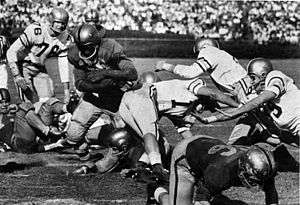Bobby Grier (American football)
Bobby Grier (born 1933) was the first African American football player to break the color barrier of the United States collegiate Sugar Bowl game, in 1956, which is held in New Orleans, Louisiana. Particularly in the deep South, the mid-1950s was a period of strident racial segregation for sports, as well as other areas of life. At the time, Grier's participation as a fullback and linebacker against a segregated all-white team on such a prestigious "stage" was a tremendously significant event.
.jpg) Grier from 1956 Owl | |
| Pittsburgh Panthers | |
|---|---|
| Position | Fullback, linebacker |
| Career history | |
| College |
|
| Personal information | |
| Born: | 1933 (age 86–87) |
Biography
Grier grew up in Massillon, Ohio and after playing college football at Pittsburgh joined the Air Force for a number of years. He retired from military service to be an administrator at a Pittsburgh community college and is still active in the Pittsburgh community.
1956 Sugar Bowl

Much controversy preceded the 1956 Sugar Bowl, where Grier's Pitt Panthers would meet the Yellow Jackets from Georgia Tech. There was controversy over whether Grier should be allowed to play, and whether Georgia Tech would participate in the contest. Georgia Governor, Marvin Griffin, was very publicly opposed to racial integration.[1] A measure for the tenor of this time period is the well known case of Emmett Till being subjected to a lynching in Mississippi, which occurred the previous summer to the 1956 game. Additionally, within thirty days prior, Rosa Parks ignited the Montgomery bus boycott, where she, in protest, refused to relinquish her seat on a Montgomery, Alabama transit bus.
A large contingent from the New Orleans community, as well as many related to Georgia Tech, openly fought to bar either Grier, Pitt, or the Yellow Jacket team from the game. Georgia Tech's president, coach, students and football players from the Atlanta-based school, civil rights leaders from multiple locales, as well as a large number of the Pitt community, however, succeeded in seeing Grier take to the gridiron that January day.
In anticipation of Grier's presence against Georgia Tech, Georgia governor Marvin Griffin, in December 1955, publicly sent a telegram to his state's Board Of Regents imploring that teams from Georgia not engage in racially integrated events which had blacks either as participants or in the stands. Georgia Tech's president Blake Ragsdale Van Leer rejected this request, which would not serve him well in the 1950s. Griffin would later request that President Van Leer and Georgia Tech's players be punished, Van Leer stuck to his statements and later received a standing ovation from the faculty senate.[2]
Georgia Tech won the game 7-0. The margin of victory mostly resulted from a disputed first quarter pass interference penalty which was called on Grier. Photographic evidence later strongly indicated the referee's call was incorrect.
The irony of the bad call is that it was made by referee Rusty Coles, from the Pittsburgh area, who had no objective in making the wrong call, but simply made a mistake, which he admitted after seeing the game films.
Grier's participation in the 1956 Sugar Bowl, as well as the support he received from various communities, is seen by some experts as a milestone in American race relations.[3]
In 2019, Grier was elected as a member of the Sugar Bowl Hall of Fame.[4]
References
- "A Time For Change: Bobby Grier And The 1956 Sugar Bowl". blackathlete.net. Retrieved May 9, 2016.
- Jake Grantl (2019-11-14). "Rearview Revisited: Segregation and the Sugar Bowl". Georgia Tech. Retrieved 2019-11-14.
- "A Time For Change: Bobby Grier And The 1956 Sugar Bowl". blackathlete.net. Retrieved May 9, 2016.
- Ivan Maisel (2019-02-26). "'The South Stands at Armageddon': Breaking the Sugar Bowl color barrier". ESPN. Retrieved 2019-02-28.
- Zeise, Paul - Bobby Grier broke bowl's color line. The Panthers' Bobby Grier was the first African-American to play in Sugar Bowl Pittsburgh Post-Gazette, October 7, 2005
- Thamel, Pete - Grier Integrated a Game and Earned the World's Respect. New York Times, Published: January 1, 2006.